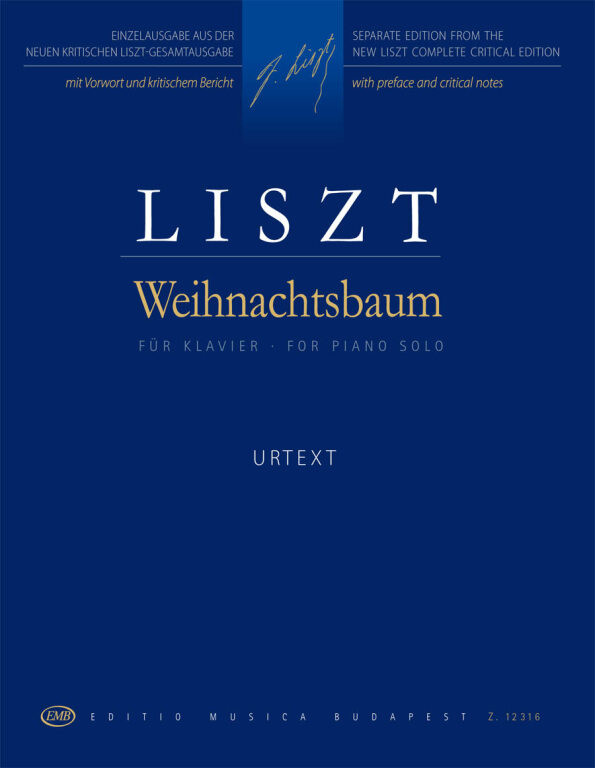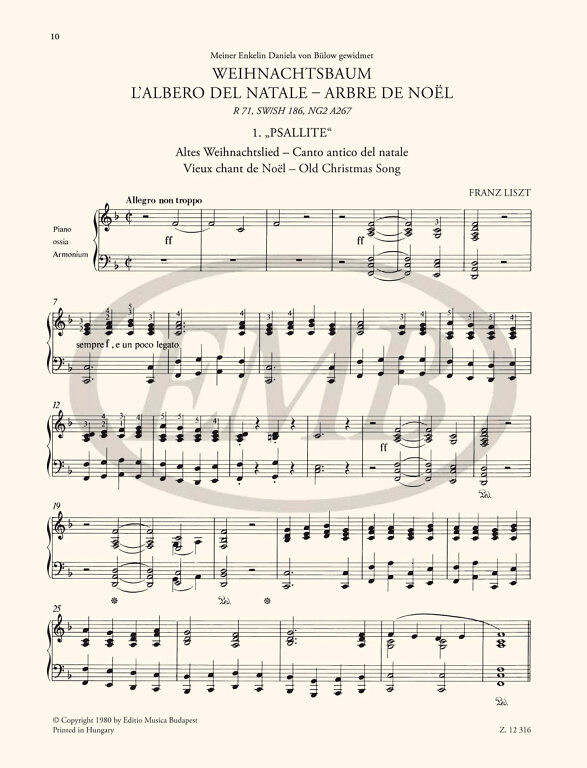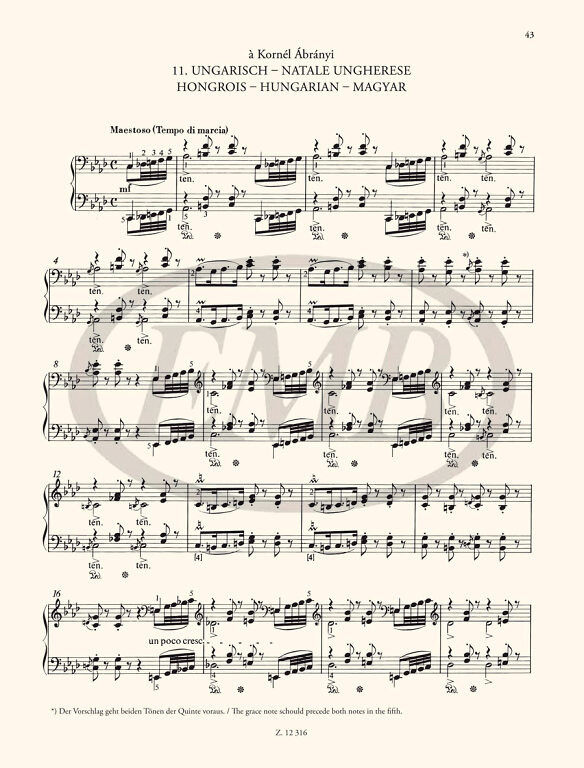Description
Liszt Ferenc: Christmas Tree (Nos 1-12) / New, enlarged edition (R 71, SW/SH 186, NG2 A267) / Preface by Kaczmarczyk Adrienne / Edited by Sulyok Imre, Mező Imre / Editio Musica Budapest Zeneműkiadó / 1982 / Előszó: Kaczmarczyk Adrienne / Közreadta Sulyok Imre, Mező Imre
Paperback
Made in Hungary
Setting: Piano
Series: Separate editions from the New Liszt Complete Critical Edition
Length: 56 pages
Format: 23 x 30 cm
Weight: 0.16 kg
Published: 1982
Publisher: Editio Musica Budapest Zeneműkiadó
Item number: 12316
ISMN: 9790080123164 / 979-0080123164
Hangszer/letét: Zongora
Sorozat: Az Új Liszt-Összkiadásban megjelent művek önálló kiadásai
Terjedelem: 56 oldal
Formátum: 23 x 30 cm
Súly: 0,16 kg
Első megjelenés: 1982
Kiadó: Editio Musica Budapest Zeneműkiadó
Katalógusszám: 12316
Liszt completed Weihnachtsbaum (Christmas Tree), a collection of twelve short piano pieces, in 1876. Two years earlier he laid out its concept in a letter to Carolyne zu Sayn-Wittgenstein as follows: ''These will not be learned or ostentatious works, but simple reflections of my youthful emotions which remain indestructible across the trials of the years.'' Weihnachtsbaum belongs among the handful of compositions by Liszt that turn towards the world of children and, at least in part, reflect their emotions.
Five pieces of the collection are arrangements of Christmas carols of various origins. The remaining character pieces were written using themes by the composer himself. Liszt dedicated Weihnachtsbaum to his eldest grandchild Daniela von Bülow, whose correspondence with Liszt suggests an especially close relationship. The ceremonial first performance took place at Christmas of the same year: Daniela visited her grandfather in Rome, who played the gift he had intended for her.
This revised (2020) edition adopts the score and the critical report of the New Liszt Edition (amending it, if necessary). In addition, it includes a preface in German and English, that explores the genesis of the work on the basis of current research, and orients the reader in issues of notation.
Liszt 1876-ben készült el Karácsonyfa című, tizenkét rövid zongoradarabból álló gyűjteményével. Két évvel korábban így írt Carolyne von Sayn-Wittgensteinnak elképzeléséről: ''(a darabok) nem tudományos értékű vagy ünnepi művek lesznek, hanem ifjúkorom érzéseinek egyszerű visszhangjai: ezek kitörölhetetlenül megmaradnak az évek összes megpróbáltatásain át is.'' A Karácsonyfa Liszt azon kevés műve közé tartozik, amelyek a gyermeki világ felé fordulnak, és amelyekben - legalábbis részben - a gyermek érzései tükröződnek.
A sorozat öt darabjában Liszt különféle eredetű karácsonyi énekeket dolgozott fel, a többi karakterdarabot saját témákra komponálta. A Karácsonyfát Liszt legidősebb unokájának, Daniela von Bülow-nak ajánlotta, aki - leveleik meghitt hangja szerint - különösen közel állt hozzá unokái közül. Az ünnepélyes bemutatóra 1881 karácsonyán került sor: Daniela meglátogatta nagyapját Rómában, aki maga zongorázta el a neki szánt ajándékot.
Kiadásunk átveszi és, ahol szükséges, javítja az Új Liszt-Összkiadás kottaszövegét és kritikai jegyzeteit. Emellett német és angol nyelvű előszót tartalmaz, amely a legújabb kutatási eredmények alapján bemutatja a darab keletkezéstörténetét, és eligazít a notáció kérdéseiben.
Contents / Tartalomjegyzék
|
1. |
'Psallite' - Old Christmas Song |
|
|
2. |
O holy night - Christmas Song of the Olden Time |
|
|
3. |
The Shepherds at the manger (In dulci jubilo) |
|
|
4. |
Adeste fideles - March of the Three Holy Kings |
|
|
5. |
Scherzoso - Little Scherzo 'Lighting the Tree' |
|
|
6. |
'Carillon' - Chimes |
|
|
7. |
Slumber song |
|
|
8. |
Old Provencal Christmas Song |
|
|
9. |
Evening Bells |
|
|
10. |
Old Times |
|
|
11. |
Hungarian |
|
|
12. |
Polish |


















